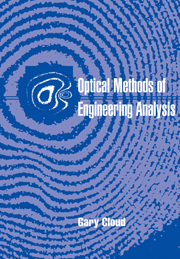Book contents
- Frontmatter
- Contents
- Acknowledgments
- 1 Introduction and orientation
- Part I Optics and interferometry
- Part II Photoelasticity
- Part III Geometrical moire
- Part IV Diffraction theory, optical processing, and moire
- Part V Moire interferometry
- Part VI Holographic interferometry
- 16 Holographic interferometry theory
- 17 Holographic interferometry methods
- Part VII Speckle methods
- Author index
- Subject index
17 - Holographic interferometry methods
Published online by Cambridge University Press: 12 January 2010
- Frontmatter
- Contents
- Acknowledgments
- 1 Introduction and orientation
- Part I Optics and interferometry
- Part II Photoelasticity
- Part III Geometrical moire
- Part IV Diffraction theory, optical processing, and moire
- Part V Moire interferometry
- Part VI Holographic interferometry
- 16 Holographic interferometry theory
- 17 Holographic interferometry methods
- Part VII Speckle methods
- Author index
- Subject index
Summary
This chapter deals with the apparatus, materials, and experimental details involved in making simple holograms and in performing holographic interferometry to obtain data indicative of shape, deformation, stress, or other phenomena. The practitioner is reminded that, except for stability requirements and restrictions on maximum path length difference, holography is very forgiving. There are some fundamental rules, but a multitude of setups and materials can be made to work. There is much room for inventiveness and resourcefulness. Also, there are many details, and experimenters who want to go beyond the basics should review at least some of the standard literature (Jones and Wykes 1989; Ranson, Sutton, and Peters 1987; Smith 1975; Vest 1979; Waters 1974).
Some basic rules
Before getting into laboratory details, some fundamental requirements for successful holography should be summarized. These are derived from theoretical considerations and from experience.
The apparatus must be stable for the duration of the exposure. In interferometry, this stability requirement extends through the viewing of the real-time fringes or for the period of recording both exposures in the frozen-fringe technique. Recall that the process involves recording a grating structure caused by two-beam interference. Motions attaining a fraction of a wavelength of light between any of the optical components will cause the grating to move in space so it cannot be recorded. The setup must be isolated from floor vibrations, air-coupled sound waves that might cause resonance of one of the optical components, and thermal transients.
The optical path length differences must not be so large that interference cannot Occur.
- Type
- Chapter
- Information
- Optical Methods of Engineering Analysis , pp. 374 - 392Publisher: Cambridge University PressPrint publication year: 1995

